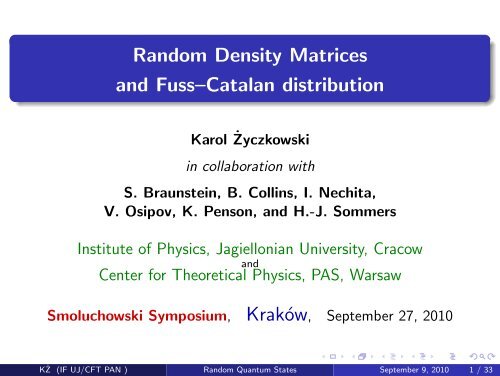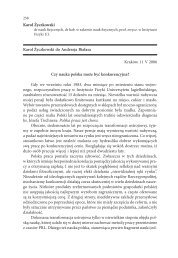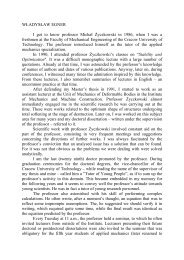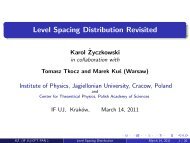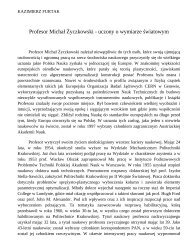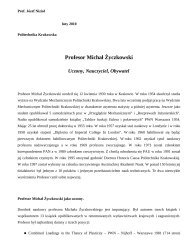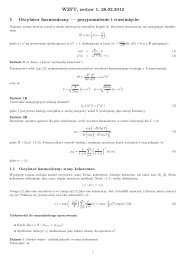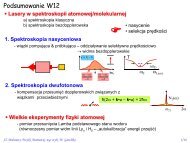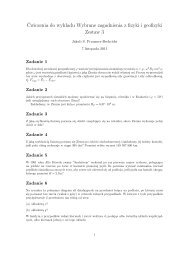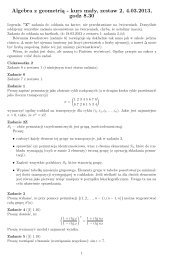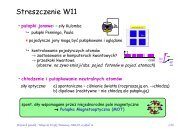Random Density Matrices and Fuss–Catalan distribution
Random Density Matrices and Fuss–Catalan distribution
Random Density Matrices and Fuss–Catalan distribution
You also want an ePaper? Increase the reach of your titles
YUMPU automatically turns print PDFs into web optimized ePapers that Google loves.
<strong>R<strong>and</strong>om</strong> <strong>Density</strong> <strong>Matrices</strong><br />
<strong>and</strong> <strong>Fuss–Catalan</strong> <strong>distribution</strong><br />
Karol ˙Zyczkowski<br />
in collaboration with<br />
S. Braunstein, B. Collins, I. Nechita,<br />
V. Osipov, K. Penson, <strong>and</strong> H.-J. Sommers<br />
Institute of Physics, Jagiellonian University, Cracow<br />
<strong>and</strong><br />
Center for Theoretical Physics, PAS, Warsaw<br />
Smoluchowski Symposium, Kraków, September 27, 2010<br />
K ˙Z (IF UJ/CFT PAN ) <strong>R<strong>and</strong>om</strong> Quantum States September 9, 2010 1 / 33
Dedicated to the memory of<br />
Dr Ryszard Zygad̷lo, 1964 - 2010<br />
Assistant Professor at Smoluchowski Institute of Physics,<br />
Jagiellonian University,<br />
Organiser of recent editions of Smoluchowski Symposia<br />
K ˙Z (IF UJ/CFT PAN ) <strong>R<strong>and</strong>om</strong> Quantum States September 9, 2010 2 / 33
Ensembles of r<strong>and</strong>om density operators<br />
Mixed quantum state = density operator which is<br />
a) Hermitian, ρ = ρ † ,<br />
b) positive, ρ ≥ 0,<br />
c) normalized, Trρ = 1.<br />
Let MN denote the set of density operators of size N.<br />
Ensembles of r<strong>and</strong>om states in MN<br />
Let A be matrix from an arbitrary ensemble of r<strong>and</strong>om matrices.<br />
Then<br />
ρ = AA†<br />
TrAA †<br />
forms a r<strong>and</strong>om quantum state<br />
K ˙Z (IF UJ/CFT PAN ) <strong>R<strong>and</strong>om</strong> Quantum States September 9, 2010 3 / 33
The ensemble analyzed<br />
Wk,s :=<br />
<br />
p1U1 + p2U2 + · · · + pkUk<br />
<br />
G1 · · · Gs<br />
where Ui are independent Haar r<strong>and</strong>om unitary matrices in U(N),<br />
while Gi are independent (rectangular) r<strong>and</strong>om Ginibre matrices <strong>and</strong><br />
p = {p1, . . .,pk} is a probability vector.<br />
Define ensemble of normalized r<strong>and</strong>om density matrices of size N<br />
ρk,s := Wk,sW †<br />
k,s<br />
/Tr(Wk,sW †<br />
k,s )<br />
* 1) What ensembles can be generated in this way?<br />
* 2) What are their statistical properties ?<br />
* 3) How these r<strong>and</strong>om states may emerge in quantum physics?<br />
* 4) How to generate numerically r<strong>and</strong>om matrices from certain<br />
ensembles, (e.g. Bures ensemble) ?<br />
K ˙Z (IF UJ/CFT PAN ) <strong>R<strong>and</strong>om</strong> Quantum States September 9, 2010 4 / 33
Having at your disposal LEGO pieces of two kinds:<br />
a) rectangular pieces (r<strong>and</strong>om Ginibre matrices)<br />
b) round pieces (Haar r<strong>and</strong>om unitary matrices)<br />
What can you construct out of them ?<br />
K ˙Z (IF UJ/CFT PAN ) <strong>R<strong>and</strong>om</strong> Quantum States September 9, 2010 5 / 33
How r<strong>and</strong>om mixed states<br />
appear in quantum physics ?<br />
Reduction of r<strong>and</strong>om pure states<br />
1) Consider an ensemble of r<strong>and</strong>om pure states |ψ〉 of<br />
a composite system distributed according to a given<br />
measure µ.<br />
2) Perform partial trace over a chosen subsystem B to<br />
get a r<strong>and</strong>om mixed state<br />
ρ : = TrB|ψ〉〈ψ|<br />
Depending on the structure of the composite system, the initial measure<br />
µ in the space of the pure states <strong>and</strong> the choice of the subsystem B, over<br />
which the averaging is performed<br />
one obtaines different ensembles of r<strong>and</strong>om mixed states.<br />
K ˙Z (IF UJ/CFT PAN ) <strong>R<strong>and</strong>om</strong> Quantum States September 9, 2010 6 / 33
Pure states in a finite dimensional Hilbert space HN<br />
Space of normalized complex pure states for an arbitrary N:<br />
Since 〈ψ|ψ〉 = 1 a normalized state belongs to the sphere S 2N−1 .<br />
Two states equal up to a phase are identified, |ψ〉 ∼ e iα |ψ〉, so the set of<br />
states is equivalent to the complex projective space P N−1<br />
of 2N − 2 real dimensions.<br />
N = 2: For qubit = quantum bit the word geometry<br />
can be treated literally!<br />
|ψ〉 = cos ϑ<br />
2 |1〉 + eiφ sin ϑ<br />
2 |0〉<br />
P 1 = Bloch sphere of N = 2 pure states<br />
K ˙Z (IF UJ/CFT PAN ) <strong>R<strong>and</strong>om</strong> Quantum States September 9, 2010 7 / 33
<strong>R<strong>and</strong>om</strong> Pure states in HN<br />
’Quantum chaotic’ dynamics (pseudo-r<strong>and</strong>om evolution)<br />
described by a r<strong>and</strong>om unitary matrix U acting on a pure state produces<br />
(almost surely) a ’generic pure state’ |ψ〉 = U|φ0〉.<br />
• Formally one defines an (unique) Fubini–Study measure µ on complex<br />
projective spaces which is unitarily invariant: for any (measurable) set A<br />
of states one requires µ(A) = µ(U(A)).<br />
• This measure covers the entire space P N−1 uniformly, <strong>and</strong> for N = 2<br />
it is just equivalent to the uniform, Lebesgue measure on the sphere S 2 .<br />
How to obtain numerically a r<strong>and</strong>om pure state |ψ〉 ?<br />
a) Take a column (a row) of a r<strong>and</strong>om unitary U so that |ψ〉 = U|i〉.<br />
b) generate N independent complex r<strong>and</strong>om numbers zi according to<br />
the normal <strong>distribution</strong>. Write |ψ〉 = N i=1 ci|i〉 where the expansion<br />
coefficients read ci = zi/ <br />
i |zi| 2 .<br />
K ˙Z (IF UJ/CFT PAN ) <strong>R<strong>and</strong>om</strong> Quantum States September 9, 2010 8 / 33
Ryszard with Ewa during an earlier Smoluchowski Symposium<br />
K ˙Z (IF UJ/CFT PAN ) <strong>R<strong>and</strong>om</strong> Quantum States September 9, 2010 9 / 33
Composed systems & entangled states<br />
bi-partite systems: H = HA ⊗ HB<br />
separable pure states: |ψ〉 = |φA〉 ⊗ |φB〉<br />
entangled pure states: all states not of the above product form.<br />
Two–qubit system: d = 2 × 2 = 4<br />
Maximally entangled Bell state |ϕ + 〉 := 1<br />
<br />
√ |00〉 + |11〉<br />
2<br />
Entanglement measures<br />
For any pure state |ψ〉 ∈ HA ⊗ HB define its partial trace σ = TrB|ψ〉〈ψ|.<br />
Definition: Entanglement entropy of |ψ〉 is equal to von Neumann<br />
entropy of the partial trace<br />
E(|ψ〉) := −Tr σ lnσ<br />
The more mixed partial trace, the more entangled initial pure state...<br />
K ˙Z (IF UJ/CFT PAN ) <strong>R<strong>and</strong>om</strong> Quantum States September 9, 2010 10 / 33
Entanglement of two real qubits<br />
Entanglement entropy at the tetrahedron of d = 4 real pure states<br />
K ˙Z (IF UJ/CFT PAN ) <strong>R<strong>and</strong>om</strong> Quantum States September 9, 2010 11 / 33
More on this is can be found in<br />
I. Bengtsson <strong>and</strong> K. ˙Zyczkowski, Geometry of Quantum States<br />
(Cambridge, 2006, 2008)<br />
K ˙Z (IF UJ/CFT PAN ) <strong>R<strong>and</strong>om</strong> Quantum States September 9, 2010 12 / 33
Generic pure states of a bi-partite system<br />
’Two quNits’ = N × N quantum system<br />
The space P N2 −1 of all states in H = HN ⊗ HN has dtot = N 2 − 2<br />
dimensions.<br />
The subspace of separable (product) states P N−1 × P N−1 has only<br />
dsep = 2(N − 2) dimensions. For large N we observe that<br />
dsep ∼ 2N
Average entanglement entropy for a bipartite system<br />
N × N system<br />
〈S(ψ)〉ψ ≈ lnN − 1<br />
2<br />
<br />
+ OlnN<br />
N<br />
N × K system: formula of Don Page (1993/1995)<br />
valid for r<strong>and</strong>om states in HN ⊗ HK with K ≥ N<br />
〈S(ψ)〉ψ = Ψ(NK + 1) − Ψ(K + 1) −<br />
N × K system: probability measure<br />
N − 1<br />
2K<br />
≈ lnN − N<br />
2K .<br />
Let λ = {λ1, . . .λN} denote the spectrum of the reduced matrix<br />
ρ := TrB|ψ〉〈ψ|. If |ψ〉 is taken uniformly on HN ⊗ HK then<br />
PN,K(λ) = CN,K δ 1 − <br />
i λi<br />
<br />
i λK−N<br />
<br />
i i
Composed bi–partite systems on HA ⊗ HB<br />
Ensembles obtained by partial trace: a) induced measure<br />
i) natural measure on the space of pure states obtained by acting on a<br />
fixed state |0, 0〉 with a global r<strong>and</strong>om unitary UAB of size NK<br />
|ψ〉 =<br />
N<br />
i=1<br />
K<br />
Gij|i〉 ⊗ |j〉<br />
j=1<br />
ii) partial trace over the K dimensional subsystem B gives<br />
ρA = TrB|ψ〉〈ψ| <strong>and</strong> leads to the induced measure PN,K(λ) in the space<br />
of mixed states of size N. Integrating out all eigenvalues but λ1 one<br />
arrives (for large N) at the Marchenko–Pastur <strong>distribution</strong> Pc(x = Nλ1)<br />
with the parameter c = K/N.<br />
K ˙Z (IF UJ/CFT PAN ) <strong>R<strong>and</strong>om</strong> Quantum States September 9, 2010 15 / 33
Spectral properties of r<strong>and</strong>om matrices<br />
Non-hermitian matrix G of size N of the Ginibre ensemble<br />
Under normalization TrGG † = N<br />
the spectrum of G fills uniformly<br />
(for large N!) the unit disk<br />
The so–called circular law of Girko !<br />
Hermitian, positive matrix ρ = GG † of the Wishart ensemble<br />
Let x = Nλi, where {λi} denotes the spectrum of ρ. As Trρ = 1 so<br />
〈x〉 = 1. Distribution of the spectrum P(x) is asymptotically given by the<br />
Marchenko–Pastur law<br />
π (1) (x) = PMP(x) = 1<br />
<br />
4<br />
2π x − 1 for x ∈ [0, 4]<br />
K ˙Z (IF UJ/CFT PAN ) <strong>R<strong>and</strong>om</strong> Quantum States September 9, 2010 16 / 33
Composed bi–partite systems II<br />
b) Arcsine ensemble<br />
i) Consider a superposition of two maximally entangled states on<br />
HN ⊗ HN<br />
|φ〉 = |ψ +<br />
AB 〉 + (UA ⊗ N)|ψ +<br />
AB 〉, where |ψ+ AB 〉 = (1/√N) N i=1 |i, i〉,<br />
while UA ∈ U(N) is a Haar r<strong>and</strong>om unitary matrix with phases αi.<br />
ii) The reduced state ρA = TrB|φ〉〈φ|<br />
〈φ|φ〉<br />
= 2 +UA+U †<br />
A<br />
2N+Tr(UA+U †<br />
A ).<br />
has the spectrum λi = (1 + cosαi)/N for i = 1, . . .,N. Thus for large N<br />
the spectral density has the form of the arcsine <strong>distribution</strong>,<br />
1 Parc(x) =<br />
π √ with support x ∈ [0, 2], where x = Nλ.<br />
x(2−x)<br />
K ˙Z (IF UJ/CFT PAN ) <strong>R<strong>and</strong>om</strong> Quantum States September 9, 2010 17 / 33
c) Generalization for k states<br />
i) Superposition of k maximally entangled states on HN ⊗ HN<br />
|φ〉 = k i=1 (Ui ⊗ N)|ψ +<br />
AB 〉,<br />
where Ui ∈ U(N) are independent Haar r<strong>and</strong>om unitary matrices.<br />
ii) The reduced state ρA = TrB|φ〉〈φ|<br />
〈φ|φ〉<br />
†<br />
(U1+···+Uk)(U 1 = +···+U† k )<br />
Tr(U1+···+Uk)(U †<br />
1 +···+U† k<br />
is<br />
).<br />
asymptotically characterized by the leads to a Kesten <strong>distribution</strong><br />
√ 4k(k−1)x−k 2 x 2<br />
Pk(x) = 1<br />
2π kx−x 2<br />
which belongs to free Meixner laws (Bo˙zejko, Bryc 2006)<br />
with support x ∈ [0, 4(k − 1)/k],<br />
where x = Nλ.<br />
Observe that for k → ∞ the<br />
<strong>distribution</strong> Pk tends to<br />
Marchenko-Pastur π (1) , as the<br />
renormalized sum of many<br />
independent r<strong>and</strong>om unitaries bahaves<br />
as a Ginibre matrix .<br />
K ˙Z (IF UJ/CFT PAN ) <strong>R<strong>and</strong>om</strong> Quantum States September 9, 2010 18 / 33
d) Bures ensemble<br />
i) Consider a superposition of two pure states: a r<strong>and</strong>om state |ψ1〉 <strong>and</strong><br />
the same state transformed by a local unitary VA,<br />
|φ〉 := ( ⊗ + VA ⊗ )|ψ1〉, where |ψ1〉 = UAB|0, 0〉<br />
while VA ∈ U(N) <strong>and</strong> UAB ∈ U(N 2 ) are Haar r<strong>and</strong>om unitary matrices.<br />
( +VA)GG † ( +V †<br />
A )<br />
Tr[( +VA)GG † ( +V †<br />
A<br />
ii) The reduced state ρB =<br />
is distributed according<br />
)]<br />
to the Bures measure, PB(λ1, ...λN) = CB <br />
N i λ−1/2<br />
1...N (λi −λj)<br />
i i
Composed mutipartite systems & projections<br />
a) Four-partite system & π (2) <strong>distribution</strong><br />
Take a four-partite product state,<br />
|ψ0〉 = |0〉A ⊗ |0〉B ⊗ |0〉C ⊗ |0〉D =: |0, 0, 0, 0〉 ∈ HN ⊗4 .<br />
i) Apply two r<strong>and</strong>om unitary matrices UAB <strong>and</strong> UCD of size N 2 ,<br />
|ψ〉 = UAB ⊗ UCD|ψ0〉 = N<br />
i,j=1<br />
ii) Consider projector P := A ⊗ |Ψ +<br />
BC 〉〈Ψ+<br />
on the maximally entangled state, |Ψ +<br />
BC<br />
N<br />
k,l=1 GijEkl |i〉A ⊗ |j〉B ⊗ |k〉C ⊗ |l〉D<br />
BC | ⊗ D<br />
√<br />
N<br />
〉 = 1<br />
The spectrum of the iii) reduced state ρA = TrD|φ〉〈φ|<br />
〈φ|φ〉<br />
N<br />
µ=1 |µ〉B ⊗ |µ〉C<br />
= GEE † G †<br />
Tr GEE † G †<br />
consists of squared singular values of the product GE<br />
of two independent Ginibre matrices, so the spectral density<br />
is described by the Fuss-Catalan <strong>distribution</strong> π (2) (x).<br />
K ˙Z (IF UJ/CFT PAN ) <strong>R<strong>and</strong>om</strong> Quantum States September 9, 2010 20 / 33
) 2s-partite system & π (s) Fuss-Catalan <strong>distribution</strong><br />
Take a 2s-partite product state,<br />
|ψ0〉 = |0〉1 ⊗ · · · ⊗ |0〉2s ∈ HN ⊗2s .<br />
i) Apply s r<strong>and</strong>om unitary matrices U1,2, U3,4,.. U2s−1,2s of size N 2 each,<br />
|ψ〉U1,2 ⊗ · · ·U2s−1,2s|0, . . .,0〉 = <br />
i1,...i2s (G1)i1,i2 · · ·(Gs)i2s−1,i2s |i1, . . .,i2s〉<br />
ii) Project onto the product of (s − 1) maximally entangled states,<br />
Ps := 1 ⊗ |Ψ + 2,3 〉〈Ψ+ 2,3 | ⊗ · · · ⊗ |Ψ+ 2s−2,2s−1 〉〈Ψ+ 2s−2,2s−1 | ⊗ 2s<br />
The spectrum of the iii) reduced state<br />
ρA = Tr2s|φ〉〈φ|<br />
†<br />
G1G2···Gs(G1G2···Gs)<br />
〈φ|φ〉 = Tr [G1G2···Gs(G1G2···Gs) † ]<br />
consists of squared singular values of the product G1 · · ·Gs<br />
of s independent Ginibre matrices, so the spectral density<br />
is described by the Fuss-Catalan <strong>distribution</strong> π (s) (x).<br />
K ˙Z (IF UJ/CFT PAN ) <strong>R<strong>and</strong>om</strong> Quantum States September 9, 2010 21 / 33
Fuss-Catalan <strong>distribution</strong> π (s)<br />
defined for an integer number s is characterized by its moments<br />
<br />
p (s) 1 sp+p (s)<br />
x π (x)dx = sp+1 p =: FC p<br />
equal to the generalized Fuss-Catalan numbers .<br />
The density π (s) is analitic on the support [0, (s + 1) s+1 /s s ],<br />
while for x → 0 it behaves as 1/(πx s/(s+1) ).<br />
The same moments decribe (asymptotically) <strong>distribution</strong> of singular values<br />
for s–th power of Ginibre G s , (Alexeev, Götze, Tikhomirov 2010)<br />
K ˙Z (IF UJ/CFT PAN ) <strong>R<strong>and</strong>om</strong> Quantum States September 9, 2010 22 / 33
Fuss-Catalan <strong>distribution</strong>s π (s)<br />
The moments of π (s) are equal to Fuss-Catalan numbers.<br />
Using inverse Mellin transform one can represent π (s) by the Meijer<br />
G–function, which in this case reduces to s hypergeometric functions<br />
Exact explicit expressions for FC π (s)<br />
s = 1, π (1) (x) = 1<br />
π √ x 1F0<br />
<br />
−1 1<br />
2 ; ; 4x <br />
=<br />
s = 2, π (2) <br />
(x) =<br />
= 3√ 2 √ 3<br />
12π<br />
√<br />
3<br />
2πx2/3 2F1<br />
− 1<br />
6<br />
, 1<br />
3<br />
; 2<br />
3<br />
; 4x<br />
27<br />
√ 1−x/4<br />
π √ x<br />
<br />
−<br />
3√ 2(27+3 √ 81−12x) 2 3 −6 3 √ x<br />
x 2 3(27+3 √ 81−12x) 1 3<br />
, Marchenko–Pastur<br />
<br />
=<br />
√<br />
3<br />
6πx1/3 2F1<br />
1<br />
6<br />
<strong>Fuss–Catalan</strong><br />
Arbitrary s, ⇒ π (s) (x) is a superposition of<br />
s hypergeometric functions,<br />
π (s) (x) = s j=1 βj<br />
(j)<br />
sFs−1 a 1 , . . .,a(j) s ; b (j)<br />
1 , . . .,b(j)<br />
s−1 ; αjx .<br />
(Penson, ˙Zyczkowski, 2010)<br />
, 2<br />
3<br />
; 4<br />
3<br />
; 4x<br />
27<br />
K ˙Z (IF UJ/CFT PAN ) <strong>R<strong>and</strong>om</strong> Quantum States September 9, 2010 23 / 33
K ˙Z (IF UJ/CFT PAN ) <strong>R<strong>and</strong>om</strong> Quantum States September 9, 2010 24 / 33
Multi–partite systems: graphs<br />
Graph r<strong>and</strong>om states<br />
Consider a graph Γ consisting of m edges B1, . . .Bm <strong>and</strong> k vertices<br />
V1, . . .Vk. It represents a composite quantum system consisting of 2m<br />
sub–systems described in the Hilbert space with 2m–fold tensor product<br />
H = H1 ⊗ · · · ⊗ H2m of dimension N 2m .<br />
Each edge represents the maximally entangled state |Φ + 〉 in both<br />
subspaces, while each vertex represents a r<strong>and</strong>om unitary matrix U<br />
(Haar measure =’generic’ Hamiltonian), coupling connected systems.<br />
A simple example: three vertices & two edges<br />
V1<br />
V2<br />
V3<br />
V1<br />
V2<br />
|Φ + 12 〉 |Φ+ 34 〉<br />
V3<br />
H1 H2 H3 H4<br />
We define a r<strong>and</strong>om state |ψ〉 = (U1 ⊗ U23 ⊗ U4) |Φ +<br />
12 〉 ⊗ |Φ+ 34 〉<br />
〉 denotes the maximally entangled state in subspaces k, j.<br />
where |Φ +<br />
kj<br />
K ˙Z (IF UJ/CFT PAN ) <strong>R<strong>and</strong>om</strong> Quantum States September 9, 2010 25 / 33
Multi–partite graph systems: mixed states<br />
Partial trace over certain subspaces<br />
Consider an ensemble of r<strong>and</strong>om pure states |ψ〉 corresponding to a<br />
given graph Γ. Select a fixed subset T of subspaces <strong>and</strong> define a<br />
(r<strong>and</strong>om) mixed state ρ(T) = TrT |ψ〉〈ψ|.<br />
Tasks<br />
• Determine the spectral properties of the ensemble of mixed states<br />
ρ(T) associated with the graph Γ.<br />
• Find the mean entropy 〈S(ρ)〉ψ of the reduced state ρ averaged over<br />
the ensemble of graph r<strong>and</strong>om pure states |ψ〉Γ,T.<br />
Examples of partial trace for the graph Γ<br />
V1<br />
V3<br />
V3<br />
V2 V1 V2<br />
The partial<br />
trace is taken over all the subspaces T represented by open symbols.<br />
K ˙Z (IF UJ/CFT PAN ) <strong>R<strong>and</strong>om</strong> Quantum States September 9, 2010 26 / 33<br />
V1<br />
V3<br />
V2
Graphs <strong>and</strong> r<strong>and</strong>om multi–partite systems<br />
Partial trace over certain subspaces<br />
For ensembles of r<strong>and</strong>om states associated with certain graphs Γ <strong>and</strong><br />
selected subspaces T – cross (×) – over which the partial trace takes place<br />
V<br />
H1H2 H3H4H5H6H7H8<br />
V4<br />
|Φ + 8,1 〉<br />
|Φ + 6,7 〉<br />
H8<br />
H7<br />
H1<br />
H6<br />
V1<br />
V3<br />
H2<br />
H5<br />
V2 V1 V3<br />
one can compute moments of the traces µq := 〈Trρ q 〉ψ<br />
<strong>and</strong> then obtain bounds for the average entropy 〈S〉 = 〈−Trρ lnρ〉ψ.<br />
Collins, Nechita, ˙Zyczkowski, J. Phys. A, (2010)<br />
|Φ + 2,3 〉<br />
H3<br />
H4<br />
|Φ + 4,5 〉<br />
K ˙Z (IF UJ/CFT PAN ) <strong>R<strong>and</strong>om</strong> Quantum States September 9, 2010 27 / 33<br />
V2
Spectral properties of r<strong>and</strong>om mixed states I<br />
Example 1: 2 bonds, 4 subsystems <strong>and</strong> one bi-partite interaction U0<br />
a) π (0) – maximaly mixed state ρ = 1<br />
V1<br />
V3<br />
V2<br />
V1<br />
N<br />
V3<br />
with entropy S(ρ) = lnN<br />
or<br />
b) π (1) r<strong>and</strong>om mixed state generated according to the induced measure<br />
V1<br />
V3<br />
V2<br />
Let |ψ〉 = <br />
i<br />
V2<br />
with entropy S(ρ) ≈ lnN − 1/2<br />
<br />
j Gij|i〉 ⊗ |j〉 be a r<strong>and</strong>om pure state.<br />
Then G is a r<strong>and</strong>om matrix of Ginibre ensemble consisting of<br />
independent complex Gaussian entries normalized as |G| 2 = TrGG † = 1.<br />
The <strong>distribution</strong> of eigenvalues of a non–hermitian matrix G is given<br />
by the Girko circular law, while positive Wishart matrices<br />
ρ = TrB|ψ〉〈ψ| = GG † are described by Marchenko-Pastur law π (1) .<br />
K ˙Z (IF UJ/CFT PAN ) <strong>R<strong>and</strong>om</strong> Quantum States September 9, 2010 28 / 33
Spectral properties of r<strong>and</strong>om mixed states II<br />
Example 2: 4 bonds, 8 subsystems <strong>and</strong> four bi-partite interactions Vi<br />
c) π (2) r<strong>and</strong>om mixed state generated by the 4–cycle graph<br />
V4<br />
|Φ + 8,1 〉<br />
|Φ + 6,7 〉<br />
H8<br />
H7<br />
H1<br />
H6<br />
V1<br />
V3<br />
H2<br />
H5<br />
|Φ + 2,3 〉<br />
H3<br />
H4<br />
|Φ + 4,5 〉<br />
Mixed states with spectrum given by the<br />
Fuss-Catalan <strong>distribution</strong> π (2) (x)<br />
characterized by mean entropy<br />
S(ρ) ≈ lnN − 5/6<br />
PMP(x) = π (1) (x) <strong>and</strong> π (2) (x).<br />
V2<br />
After partial trace over crossed subsystems<br />
the r<strong>and</strong>om mixed state has the structure<br />
ρ = αG2G1G † †<br />
1G 2 ,<br />
where G1 <strong>and</strong> G2 are independent Ginibre<br />
matrices <strong>and</strong> α = 1/TrG2G1G †<br />
1<br />
G †<br />
2 .<br />
K ˙Z (IF UJ/CFT PAN ) <strong>R<strong>and</strong>om</strong> Quantum States September 9, 2010 29 / 33
Spectral properties of the ensembles analyzed<br />
Spectral density P(x) of the rescaled eigenvalue x = Nλ<br />
matrix W P(x) x → 0 support mean entropy<br />
π (0) – {1} 0<br />
+ U arcsine x −1/2 [0, 2] ln2 − 1 ≈ −0.307<br />
G M.-P. π (1) x −1/2 ( + U)G Bures x<br />
[0, 4] −1/2 = −0.5<br />
−2/3 [0, 3 √ 3] − ln2 ≈ −0.693<br />
G1G2 F–C π (2) x −2/3 [0, 63 ...<br />
G1 · · ·Gs<br />
...<br />
F–C π<br />
...<br />
4 ]<br />
...<br />
−5/6 ≈ −0.833<br />
...<br />
(s) x −s/(s+1) [0, bs] − s+1 j=2 1<br />
j<br />
Table: Ensembles of r<strong>and</strong>om mixed states obtained as normalized Wishart<br />
matrices, ρ = WW † /TrWW † . Here bs = (s + 1) s+1 /s s <strong>and</strong> the mean entropy<br />
〈S〉 = − x ln xP(x)dx.<br />
K ˙Z (IF UJ/CFT PAN ) <strong>R<strong>and</strong>om</strong> Quantum States September 9, 2010 30 / 33
Let<br />
Generalized ensemble of r<strong>and</strong>om states<br />
Wk,s :=<br />
<br />
U1 + U2 + · · · + Uk<br />
<br />
G1 · · · Gs<br />
where Ui are independent Haar r<strong>and</strong>om unitary matrices,<br />
while Gi are independent r<strong>and</strong>om Ginibre matrices.<br />
Define generalized ensemble of normalized r<strong>and</strong>om density matrices<br />
ρk,s := Wk,sW †<br />
k,s<br />
/Tr(Wk,sW †<br />
k,s )<br />
Special cases:<br />
s = 0, k = 1 ⇒ maximally mixed state<br />
s = 0, k = 2 ⇒ arcsine ensemble<br />
s = 0, k = k ⇒ k–Kesten ensemble<br />
s = 1, k = 1 ⇒ Hilbert-Schmidt ensemble<br />
s = 1, k = 2 ⇒ Bures ensemble<br />
s = s, k = 1 ⇒ s – Fuss Catalan ensemble<br />
K ˙Z (IF UJ/CFT PAN ) <strong>R<strong>and</strong>om</strong> Quantum States September 9, 2010 31 / 33
Concluding remarks<br />
<strong>R<strong>and</strong>om</strong> pure state can be obtained from any initial state |0〉 by a<br />
generic unitary evolution operator U, (corresponding e.g. to a<br />
quantized chaotic evolution), |ψ〉 = U|0〉.<br />
<strong>R<strong>and</strong>om</strong> mixed state of size N from the induced ensemble (which<br />
leads to Marchenko-Pastur spectral density) is obtained by the<br />
partial trace of a composite system in an initially r<strong>and</strong>om pure state.<br />
’Biased’ ensembles of r<strong>and</strong>om pure states + partial trace lead to<br />
other ensembles of r<strong>and</strong>om states, including (Arcsine, k–Kesten,<br />
Bures, s–Fuss-Catalan).<br />
With any graph one can associate an ensemble of r<strong>and</strong>om pure<br />
states. Selecting a set A of subsystems we define an ensemble of<br />
mixed states ρ by performing the partial trace over them. Graphs<br />
leading (asymptotically) to <strong>Fuss–Catalan</strong> <strong>distribution</strong>s π (s) (x) are<br />
identified for any s = 0, 1, 2, ....<br />
Explicit exact expresstions for the <strong>distribution</strong> <strong>Fuss–Catalan</strong><br />
<strong>distribution</strong>s π (s) (x) are derived.<br />
K ˙Z (IF UJ/CFT PAN ) <strong>R<strong>and</strong>om</strong> Quantum States September 9, 2010 32 / 33
Working with pieces of the two kinds:<br />
a) rectangular pieces (r<strong>and</strong>om Ginibre matrices)<br />
b) round pieces (Haar r<strong>and</strong>om unitary matrices)<br />
one can construct...<br />
many various ensembles of mixed quantum states !<br />
K ˙Z (IF UJ/CFT PAN ) <strong>R<strong>and</strong>om</strong> Quantum States September 9, 2010 33 / 33


